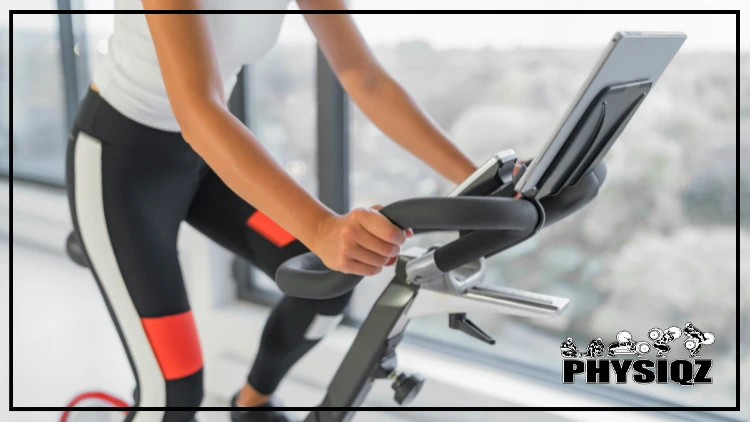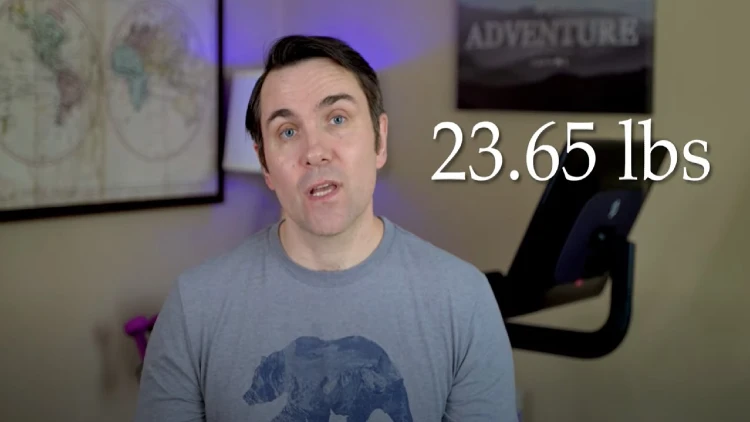
While Peloton can help you lose weight, it’s important not to rely solely on it.1 Although Peloton’s cardio workouts are effective for weight loss, combining them with strength training is essential for achieving a toned body and reducing the risk of loose skin.
Let us explain.
Peloton classes and other forms of cardio are great for burning calories but they don’t provide a full-body recomposition (fat loss + toning) in the same way as a typical workout program or Peloton Strength class.
And for those who are worried about being bulky, trust us when we say you can see it coming from a long way and loose skin or being “skinny fat” are of a greater concern.
That being said, Peloton is a great way to kickstart your fitness journey and has a place in any workout routine; so we’ll cover how much weight can be lost on Peloton, how long it will take, the best classes to begin with, before and after pictures and a sample workout program that incorporates one weight lifting day on top of Peloton classes.
How Effective is Peloton for Weight Loss?
The Peloton can be a great tool for weight loss. One can burn a lot of calories while riding and it also is fairly low impact so it’s possible someone would be able to ride the bike for much longer than they may be able to do other cardio workouts such as running on the treadmill.
Additionally, Peloton has a wide variety of classes from stretching, cycling, boot camp, and more. Due to the variability, the odds of finding a workout plan one enjoys are likely.
This is a huge benefit as research has shown that enjoying the workout increases long-term success and the ability to stick to the plan.2

Source: corelens via Canva.com3
On top of that, when beginning a weight loss journey, starting slow and steady can be a great way to also contribute to long-term success.
How Many Calories Does Peloton Burn in an Hour?
When it comes to burning calories through Peloton, there are a few different factors that will contribute to how many calories one will burn in an hour such as the duration, intensity, one’s body weight, body fat percentage, and gender.
Furthermore, when discussing calories burned it’s important to recognize the metabolic equivalent of a task (MET). MET is a simple way to determine the intensity of an exercise and will have a large impact on the number of calories burned.4
While the intensity of the workout will change the number of calories burned it’s possible for a low-impact Peloton cycling workout to burn about 400 calories in one hour whereas a more experienced rider who has a high-intensity workout for an hour could burn closer to 800-1,000 calories.
Why Peloton Shouldn’t Be the Only Form of Exercise for Most People
While Peloton is a great option for weight loss as with anything it comes with pros and cons.
Some of the most notable cons of using Peloton exclusively are:
- With the focus on cardio, there are limited opportunities to build a lot of muscle with the Peloton only.
- For women specifically, if they don’t build muscle as they lose weight they’re more likely to have loose skin.
- For men specifically, it’s possible to get skinny-fat which means having a low or normal BMI with a high body fat percentage and low muscle mass.
To combat the cons above, combine cardio with strength training. Even though Peloton workouts can be used to lose weight, it can be very beneficial to mix the cardio workouts one would get through Peloton with weight lifting or other strength-building exercises to build muscle alongside losing weight.
How Long Does It Take To Lose Weight Results With Peloton?
One would need to burn about 3,500 calories to lose 1 pound of fat. As someone could burn between 400 and 1,000 calories per 1-hour workout based on the intensity of the workout, it would be possible to lose between 1 and 3 pounds a week if someone is riding their Peloton 7 days a week.
If that same routine is followed for 12 weeks or about 80 days, it would be possible to lose between 12 and 20 pounds during that amount of time, with no change to diet. Of course, when the diet is adjusted there is a chance to lose even more weight during this time.
What’re the Best Peloton Classes & Instructors for Weight Loss?
Peloton offers over 10,000 different classes and a variety of different types of exercises from cycling, strength training, yoga, boot camp, and more. When considering weight loss with Peloton, the exerciser might also want to know which Peloton class is the most effective for shedding pounds.
When looking for a class that would be best for weight loss it’s important to consider one’s current physical fitness level to find a class that matches that. Out of all the different types of exercise classes offered, the spin classes will offer the highest calorie burn.
Here are some of the top calorie-burning spin classes through Peloton that will burn about 400 calories in a 30-minute workout:
- Power Zone Endurance
- HIIT and Hills
- Sweat Steady
Peloton has a lot of different instructors who all bring their own version of encouragement, music style, and intensity. Finding an instructor that meshes well with one’s personal preferences is a fantastic way to create a workout routine that is sustainable long-term and one that will be enjoyed throughout their weight loss journey.
How Often Should You Ride Peloton To Get a Flat Stomach?
A common goal for those looking to lose weight is to also lose belly fat and get a flat stomach. Initial research has shown that high-intensity exercise can have a positive impact on reducing belly fat when compared to low-intensity exercise.5
That being said, focusing on high-intensity Peloton workouts could be very beneficial for those wanting to get a flat stomach. To reach this goal, consider how frequently you should ride your Peloton.
While keeping in mind one’s current physical fitness levels, riding between 3 and 6 times a week could help one get a flat stomach. Furthermore, having 3 high-intensity workouts may be more beneficial for one to work towards getting a flat stomach versus 6 low-intensity workouts.
How Long Should You Ride Peloton To Burn Body Fat?
Alongside wondering if you can lose weight with Peloton, one may also want to burn body fat with Peloton workouts. When considering how long one should ride to burn body fat, it’s important to think about how many days a week one wants to ride and how much time one can dedicate to the workout.
Many people have had success riding their Peloton for only 20 minutes a day at a higher intensity whereas others may not be able to ride each day and instead have a longer endurance ride for fewer days a week.
It’s possible to lose between 400 and 700 calories during a 30-minute Peloton ride. To lose 1 pound of fat one would need to burn 3,500 calories.
For long-term success, someone should create a workout routine that they enjoy and that is sustainable.
Sample Peloton Workout Schedule & Program
Peloton offers so many different classes it may feel overwhelming to think of how to create a Peloton workout routine that incorporates as many classes as possible.
For those looking to lose weight with Peloton and wondering which classes to start with, here is a sample month-long Peloton workout program. It includes a new focus each week and incorporates one Peloton Strength class weekly to work on full body recomposition.

Source: valkovav via Canva.com6
There are mandatory classes on Monday, Wednesday, and Friday with optional workouts on Tuesday and Thursday. Saturday and Sunday are designated rest days.
Week 1 (Focus: Endurance)
This week’s focus is great for those wanting to increase their endurance. The rest days and optional days can be modified to fit personal preferences and schedules.
Monday: 45-Minute Power Zone Endurance Ride
Tuesday (Optional): 20-Minute Low-Impact Ride
Wednesday: Peloton Strength
Thursday (Optional): 45- Minute HRZ Endurance Ride
Friday: 45-Minute Climb Ride
Saturday: Rest Day
Sunday: Rest Day
Week 2 (Focus: Speed)
A focus on speed is a fantastic option for those looking for slightly shorter but faster rides. One would be able to burn a lot of calories due to the high-intensity of these speed rides.
Feel free to adjust the rest days and optional days as needed.
Monday: 30-Minute HIIT Ride
Tuesday (Optional): 20-Minute Low-Impact Ride
Wednesday: 45-Minute Sweat Steady Ride
Thursday (Optional): 20-Minute HIIT Ride
Friday: Peloton Strength
Saturday: Rest Day
Sunday: Rest Day
Week 3 (Focus: Strength Training)
For those looking for a cardio workout that will also build muscle, this strength training week is for you! The rides will have higher resistance leading to a deep burn in one’s muscles to help increase strength.
The rest days and optional rides can be changed to fit one’s personal preferences.
Monday: Peloton Strength
Tuesday (Optional): 30-Minute Low-Impact Ride
Wednesday: 30-Minute Climb Ride
Thursday (Optional): 20-Minute HIIT Ride
Friday: 30-Minute Power Zone Ride
Saturday: Rest Day
Sunday: Rest Day
Week 4 (Focus: Interval Training)
Interval training can be a fantastic way to build speed and endurance at once. The focus will be on high-intensity bursts followed by rest and recovery periods.
The rest days and optional rides can be altered.
Monday: 45-Minute Intervals and Arms Ride
Tuesday (Optional): 20-Minute Recovery Ride
Wednesday: 30-Minute Tabata Ride
Thursday (Optional): 10-Minute Low-Impact Ride
Friday: Peloton Strength
Saturday: Rest Day
Sunday: Rest Day
Peloton Weight Loss Success Stories
Peloton offers a great workout that can provide noticeable differences in one’s legs, core, and of course weight loss. For examples, check out the following articles that have even more Peloton success stories:
- Peloton before and after legs
- Crush your core Peloton: before and after results
- Peloton before and after pictures and results
Here are two individuals’ stories of weight loss through using the Peloton.
Both Chris and Hannah became dedicated Peloton riders and also made other small and sustainable changes to their diet.
Hannah Cho’s Peloton Results & Transformation
After pregnancy and the covid lockdown, Hannah found herself 20 pounds heavier than she wanted. She got up to her heaviest weight of 167 pounds by September 2020.
Now Hannah rides her bike 6 times a week. Over 4 months, Hannah was able to lose 30 pounds and at the 4-month mark, she weighed 137 pounds.
After having her bike for 1 year, she still consistently rides her bike 6 times a week for 20-30 minute workouts. In June 2022, Hannah weighs 129 which is the lowest weight she has seen in a significant amount of time.
She has since switched to maintenance mode. Here is a picture of Hannah in 2020 at her heaviest weight.

Hannah at her heaviest weight of 167 pounds in September 2020. Source: HelloHannahCho on Youtube7
And here is Hannah in 2022 at her lowest weight. While her entire body isn’t shown, you can see her face, namely her cheeks are much, much thinner.

Hannah in June 2022, having lost 38 pounds through consistent exercise and healthy habits, she now weighs 129 pounds, her lowest weight in a significant amount of time. Source: HelloHannahCho on Youtube7
Weight Loss With Peloton: Chris’ Results
When Chris began his Peloton before and after journey entailed working hard by riding the bike but he began to view the burned calories as extra calories he could indulge in while eating out. Once he realized that was not working for him, he began embarking on an overall health journey by riding his Peloton alongside improving his diet by limiting alcohol and desserts and focusing on eating more fruits and veggies and smaller portion sizes.
In September 2020 he weighed 223.45 pounds and in March 2021 he weighed 199.8 pounds, losing 23.65 pounds over the 6 month period. Chris rode his bike 3-4 times a week and would lift weights throughout the week as well.
Here is Chris 6 months after slightly adjusting his diet and riding his Peloton 3-4 times a week.

Chris before beginning his Peloton weight loss journey, with his weight at 223.45 pounds in September 2020. Source: Electrifying Chris on Youtube8
And here is Chris 1 year after beginning his Peloton weight loss journey. While he doesn’t specifically mention the number of pounds he’s lost there is notable weight loss from the 6-month video to 1 year.

Chris one year after starting his Peloton weight loss journey, showing significant weight loss progress. Source: Electrifying Chris on Youtube8
How To Take Full Advantage of Peloton & Achieve Weight Loss Through Proper Programming & Dieting
While some people can have weight loss success from only riding their Peloton, changing eating habits alongside exercise can be a fantastic way to not only lose weight but to gain lifelong healthy habits.9
There are several approaches to consider, such as tracking calories, focusing on intuitive eating, and incorporating other exercises like weight lifting alongside Peloton rides, to enhance weight loss efforts with Peloton.
Track Your Calories or Try Intuitive Eating
When making the decision to track calories or focus on intuitive eating there are a few different things to consider.
Something important to keep in mind is that research has shown counting calories can be associated with the presence of an eating disorder so if one is prone to those it may be best to focus on intuitive eating.10
Benefits of Counting Calories:
- Being 100% aware of what one is eating throughout the day.
- Knowing one has to log their food could motivate someone to eat healthier.
- It is easier to notice patterns around eating and ups and downs on the scale and make adjustments as necessary.
- There are countless free apps to use to count calories with some popular ones being My Fitness Pal and Lose It.
Benefits of Intuitive Eating for Weight Loss:
- There is less pressure.
- One is less likely to view different foods as “good” and “bad” and guilt associated with food is removed.
- With the focus on how one feels, one will gain more self-awareness of how foods make them feel.
A helpful in-between may be starting with calorie counting to get a good handle on how many calories certain foods are to gain awareness and once that routine is established, the dieter could make the change to intuitive eating and begin focusing on how they feel.
Gradually Increase Cardio Frequency & Length (How To Progress & Avoid Fatigue)
When first beginning a regular cardio exercise routine it’s important to recognize one’s current fitness level and start small. By starting small, one will limit the possibility of fatigue and burnout.
- For beginners (those who have been riding for less than 6 months), it may be best to start with riding their Peloton 3-4 times a week for 15-20 minute rides. As strength and endurance increase each week one could bump up the frequency and length of the rides to 4-5 rides a week and 30 to 45-minute rides.
- For moderate riders (those who have been riding for 6-12 months) exercising 5-6 times a week may fit well with their goals and current fitness level.
- For those who have been riding for over a year, it’s realistic to be riding each day or allowing one rest day.
The most important thing when slowly increasing a cardio workout is listening to one’s body and taking rests and breaks when needed. Your workouts and body will be much better off after having time off.
Incorporate Weight Lifting for a Full Body Recomposition
When one loses weight through cardio only it’s possible one’s body becomes flabby with loose skin. To create the complete dream body, it can be very helpful to incorporate weight lifting alongside cardio to build muscle while also losing body fat.
Building muscle comes with a range of benefits from limiting the possibility of injury, developing stronger bones, and enhancing one’s quality of life by improving one’s ability to do daily tasks.
Peloton does offer a wide range of classes that will build strength including strength training, boot camp, Pilates, and yoga. So one could easily pick up some strength-building classes through Peloton.
To further enhance muscle growth, weight lifting could be added to the cardio plan. Again, it’s very important to listen to one’s body to determine when breaks are necessary.
Here is a sample weekly workout program that includes Peloton cardio riding and weight lifting:
Monday: Peloton 30-Minute Endurance Ride
Tuesday: Upper Body Weight Lifting. The following information is in Sets x Reps format. So 3 x 12 means 3 sets of 12 reps.
- Dumbbell Press: 3 x 8-12
- Assisted Pull Ups: 3 x 8-12
- Optional: Tricep Push Downs: 3 x 8-12
- Optional: Bicep Curls (Dumbbell or Cable): 3 x 8-12
Wednesday: Peloton HIIT and Hills Ride
Thursday: Lower Body Weight Lifting (Back Squat)
Friday: Peloton 30-Minute Power Zone Ride
Saturday: Rest Day
Sunday: Rest Day
Note, the upper body weight lifting day may seem like very little, but it’s plenty enough for beginners. If it’s too easy, the sets can be modified from 3 to 4 sets instead.
As mentioned, cardio can be an excellent way to lose weight but to further enhance one’s results, we programmed in one weight lifting day to one muscle in conjunction with weight loss.
When considering weight loss with Peloton, the answer is yes. However, it’s important to include weight lifting in your routine to prevent becoming skinny fat and to avoid excess loose skin.
Frequently Asked Questions
Is Diet Change Necessary for Losing Weight with Peloton?
Yes, many people have successfully lost weight using Peloton without altering their diet. They instead focus on creating a regular Peloton workout routine such as riding daily or high-intensity, endurance rides at least 3 days a week.
Is Cardio on Peloton Or Weight Lifting Better to Get Slim?
Cardio on the Peloton will most likely burn more calories than weight lifting. But it would be best to do both cardio and weight lifting to build muscle alongside losing weight.
Can I Do HIIT on Peloton? How?
Yes, there are a variety of HIIT cycling classes available on Peloton. It’s also possible to do a HIIT workout on the bike and floor with the Peloton cardio app.
Is Peloton, Spin Classes, Or Outdoor Cycling Best to Get Skinny?
Each type of cycling has pros and cons. It’s most important to choose what one enjoys the most and could stick to consistently to see long-term results.
References
1Maridav. Canva. Accessed 19 April 2023. <https://www.canva.com/photos/MAE1EdV2l9w-exercise-at-home-on-spin-bicycle-fitness-workout-with-screen-woman-training-on-stationary-bike-watching-online-video-class-for-exercising-cardio-/>
2Hagberg, L. A., Lindahl, B., Nyberg, L., & Hellenius, M. L. (2009). Importance of enjoyment when promoting physical exercise. Scand J Med Sci Sports, 19(5), 740-747. <https://pubmed.ncbi.nlm.nih.gov/18694433/>
3corelens. Canva. Accessed 19 April 2023. <https://www.canva.com/photos/MAEgNl4qLT8-couple-exercising-in-the-running-track/>
4Harvard T.H. Chan School of Public Health. (2022). Staying Active. The Nutrition Source. <https://www.hsph.harvard.edu/nutritionsource/staying-active/>
5Boutcher, S. H. (2011). High-Intensity Intermittent Exercise and Fat Loss. J Obes. <https://www.ncbi.nlm.nih.gov/pmc/articles/PMC2991639/>
6valkovav. Canva. Accessed 19 April 2023. <https://www.canva.com/photos/MADQ43qoQag-indoor-cycling-at-the-gym/>
7HelloHannahCho. “Do I Still Like My Peloton Bike A Year Later? + Weight Loss Update | HelloHannahCho.” YouTube, 20 July 2022, Accessed 4 April 2023. <https://www.youtube.com/watch?v=yzgsvpP7AAo>
8Electrifying Chris. “My Peloton Bike Weight Loss Results – An honest conversation about getting results.” YouTube, 6 March 2021, Accessed 4 April 2023. <https://www.youtube.com/watch?v=0GsgdCZ1lns>
9Curioni, C. C., & Lourenco, P. M. (2005). Long-term weight loss after diet and exercise: a systematic review. Int J Obes (Lond), 29(10). <https://pubmed.ncbi.nlm.nih.gov/15925949/>
10Romano, K. A., Swanbrow Becker, M. >., Colgary, C. D., & Magnuson, A. (2018). Helpful or harmful? The comparative value of self-weighing and calorie counting versus intuitive eating on the eating disorder symptomology of college students. Eat Weight Discord, 23(6). <https://pubmed.ncbi.nlm.nih.gov/30155857/>